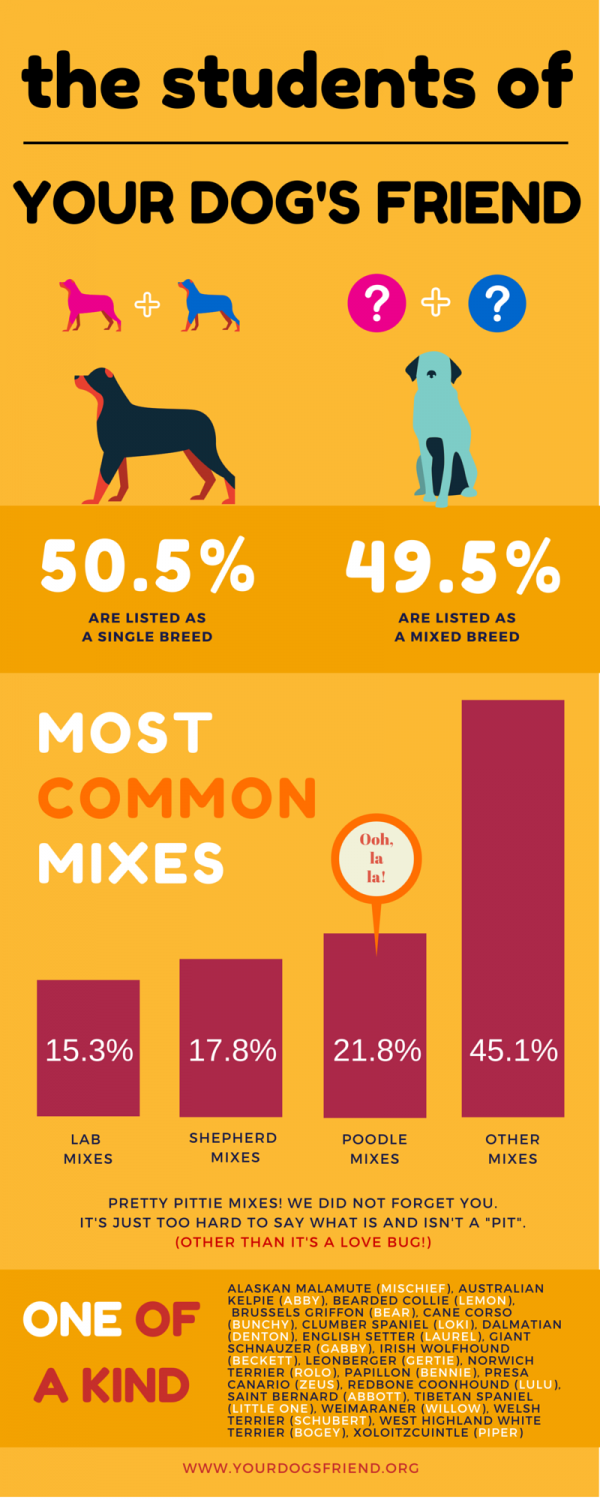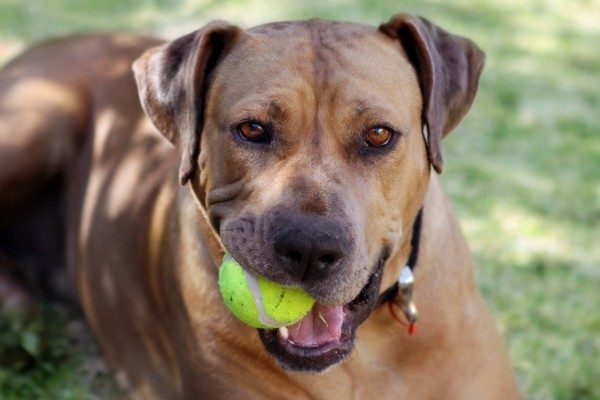INFOGRAPHIC: The Dogs of Your Dog’s Friend (2015)

Data gathered from Your Dog’s Friend student registrations from January 1 – November 24, 2015.

Data gathered from Your Dog’s Friend student registrations from January 1 – November 24, 2015.
Your dog has a problem. A BIG PROBLEM.
It’s the kind of problem that may lead to him being left at a shelter/rescue or worse, put to sleep. Where do you turn for help? How do you know whether the person will treat your dog humanely and provide an effective treatment and training plan?
Someone with an M.D. graduated from medical school.
Someone with an LCSW completed the state’s requirements to be a social worker.
Someone with a J.D. graduated from law school.
Anyone can claim to be a dog trainer. Absolutely anyone, regardless of education or ethics. It is up to you as the dog’s guardian to research the options and select the best one for your dog. (We will get into dog training certifications in another article.)
Today, we’re going to teach you how to know if someone is a dog behaviorist.
(Click the image to make it larger.)
A Vet Behaviorist (DACVB or Dip. ACVB) is a veterinarian who has received extra training in animal behavior. Your regular vet did not have to study much about animal behavior to get their DVM; that program focuses more on physical medicine than mental and behavioral health. A vet behaviorist can prescribe medication if your dog requires it and they can help you devise a management and training plan. We have a list of recommended DACVBs in the DC metro area.
A Behaviorist is someone with a Masters degree (ACAAB) or PhD (CAAB) in animal behavior. They have extensive knowledge of animal behavior and how animals (and humans!) learn. While they cannot prescribe medication like a Vet Behaviorist, they often have close relationships with local vets and can advocate on your dog’s behalf if medication would be helpful. We have a list of recommended CAABs & ACAABs in the DC metro area.
People may use terms like “behavior specialist,” “behavior consultant,” “dog therapist,” or even “behaviorist,” but unless they have a DACVB, ACAAB, or CAAB, you cannot be certain how much they really know about dog behavior.
Not all dog trainers are created equal! Be sure to ask a lot of questions and ask for testimonials from previous clients. This person may be an expert and a miracle worker or they may be the exact opposite. We have a recommended list of dog trainers in the DC metro area.
Even if you’ve never taken a class with us, you are welcome to call or email our main office for more information about positive trainers and behaviorists in the Maryland, DC, and Northern Virginia area. We are here for you and your dog!

You ready to play?
There’s a super powerful dog training technique that most average dog owners (and even some dog trainers!) have a hard time understanding. In this article, I’m going to hopefully turn on the light switch so you can have the a-ha moment and be able to harness this technique to teach your dog all sorts of fun and useful behaviors.
In our classes, we talk about various ways that you can teach your dog a new behavior without the need for harsh corrections or punishment. In case you haven’t been to one of our classes, here’s a quick review of those methods:
Of these four methods, shaping is the one that confuses people the most.
“So I just stand here?” (Yes.)
“My dog is sitting and staring at me.” (Give him time.)
“This isn’t working!” (Give it time.)
“Can’t I nudge him toward the behavior?” (Nope. That’s luring. We’re shaping!)
“So I click and treat when?” (Whenever your dog does a small part of the behavior you want.)
“This seems like I’m clicking and treating for nothing.” (It’s almost nothing, but definitely on the way to something!)
Let’s leave the dog behind for a moment and talk about your childhood. (Don’t worry, we won’t get Freudian!)
Did you ever play the game 20 Questions? If so, you’ve played a shaping game!
Bob:
Okay, I know what the object is.
Debra:
Is it alive?
Bob:
No.
Debra:
Is it in the training center?
Bob:
Yes.
Debra:
Is it blue?
Bob:
No.
Debra:
Is it a piece of agility equipment?
Bob:
No.
Debra:
Is it something a dog wears?
Bob:
No.
Debra:
Is it something a dog would play with?
Bob:
Yes.
Debra:
Is it something you throw?
Bob:
Yes.
Debra:
Is it a frisbee?
Bob:
No.
Debra:
Is it a ball?
Bob:
Yes.
Debra:
Is it a tennis ball?
Bob:
Yes! You got it!
During this game, Bob is using shaping to lead Debra to the correct answer. His Yes or No answers give her feedback and she uses that feedback to refine her line of questioning until she correctly identifies the tennis ball.
Let’s look at it again but add Debra’s thoughts to the mix.
Bob:
Okay, I know what the object is.
Debra thinks of the first step to narrowing down the name of the object.
Debra:
Is it alive?
Bob:
No.
Debra now knows it’s an inanimate object. Maybe it’s something in the room.
Debra:
Is it in the training center?
Bob:
Yes.
Debra glances around the room. There are a lot of blue things: the floor, the pods, the A-frame, the dog walk, the teeter.
Debra:
Is it blue?
Bob:
No.
Debra now looks for objects that aren’t blue. There are lots of agility obstacles that are not blue.
Debra:
Is it a piece of agility equipment?
Bob:
No.
Debra scans to the other side of the room and sees a harness hanging on the wall.
Debra:
Is it something a dog wears?
Bob:
No.
Debra keeps looking and sees the container of toys.
Debra:
Is it something a dog would play with?
Bob:
Yes.
Debra thinks about the different types of toys in the container.
Debra:
Is it something you throw?
Bob:
Yes.
Debra is getting excited because there are only a couple toys that are for throwing!
Debra:
Is it a frisbee?
Bob:
No.
So close! It has to be a ball.
Debra:
Is it a ball?
Bob:
Yes.
Yes! Debra goes one step further.
Debra:
Is it a tennis ball?
Bob:
Yes! You got it!
Hooray! Debra wins!
The 20 Questions game is an imperfect analogy since Debra knows that her goal is to identify the object Bob is thinking about. Obviously, your dog does not know the point of the game in advance. Your dog does know that he gets a click and a treat when he’s done something you like. This positive reinforcement increases the probability that he will repeat the behavior you like.
Unlike Bob, who gives a non-reward marker (“No”) to Debra when she is incorrect, we will simply wait for the dog to offer a behavior that is a “Yes.”
Your steps for shaping a new behavior:
See the process in action with this great video from ShapeFest on YouTube.
Training a Dog to Flip Open a Picnic Basket Using Shaping by Pat Miller
Shape a “Crawl Under” Trick by kikopup
Introduction to Shaping by Karen Pryor
